Financial Reporting Analysis: Comparative Study of Apple and Samsung
VerifiedAdded on 2020/04/21
|16
|3127
|281
Report
AI Summary
This report presents a financial analysis comparing the performance of Apple and Samsung. It begins with a company overview and proceeds to analyze key financial ratios, including liquidity, profitability, efficiency, capital structure, and investment ratios, providing insights into each company's financial health. The analysis extends to the cash flow statements of both companies, offering a comprehensive view of their cash management and operational efficiency. Furthermore, the report delves into the discussion of historical cost versus fair value accounting, exploring the valuation techniques as per IFRS 13, such as market, cost, and income approaches. The report concludes with a comparative assessment of the financial strategies and performance of both companies, offering valuable insights for financial analysis and decision-making. The appendix includes the financial ratios of both the companies for reference.
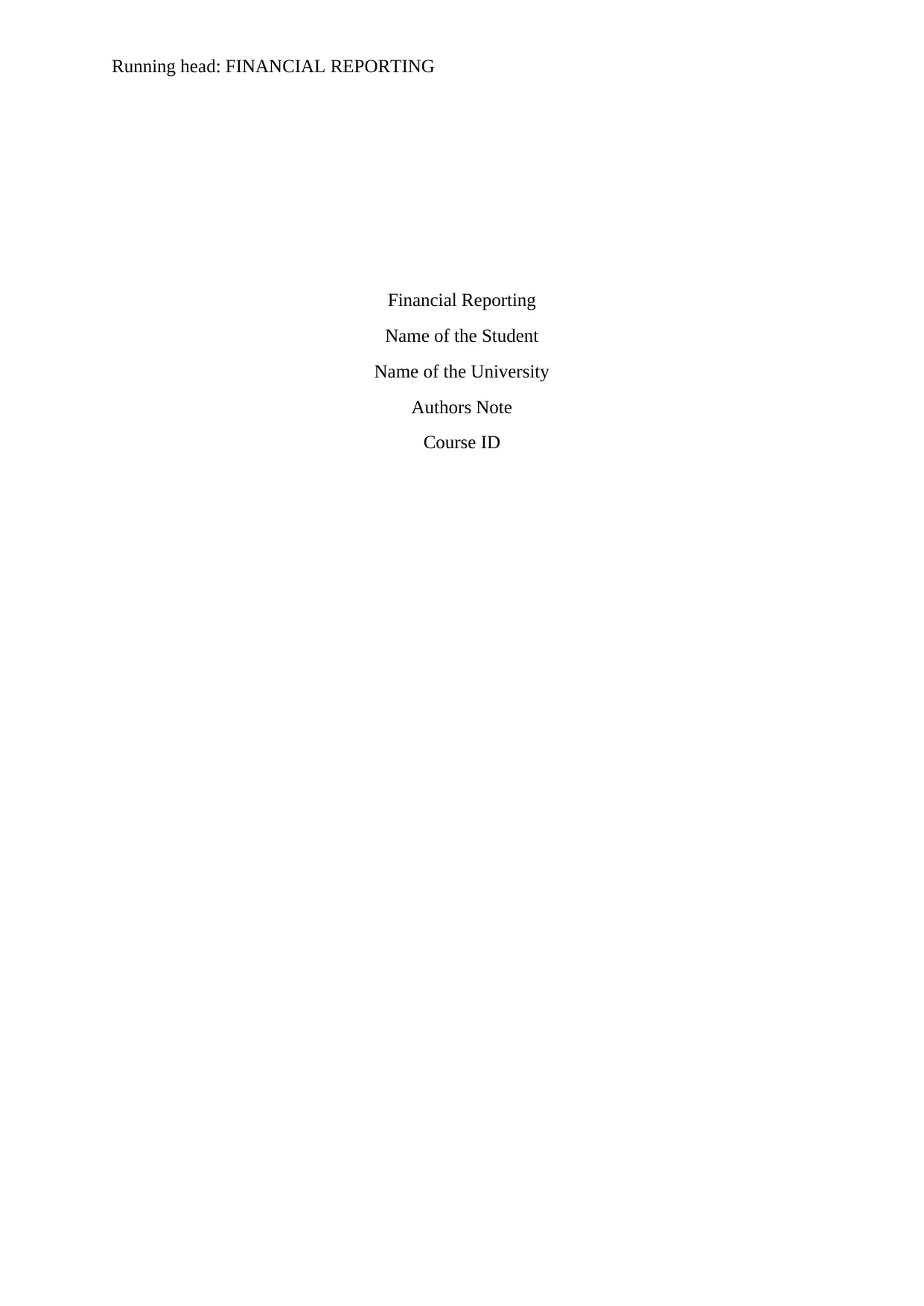
Running head: FINANCIAL REPORTING
Financial Reporting
Name of the Student
Name of the University
Authors Note
Course ID
Financial Reporting
Name of the Student
Name of the University
Authors Note
Course ID
Paraphrase This Document
Need a fresh take? Get an instant paraphrase of this document with our AI Paraphraser
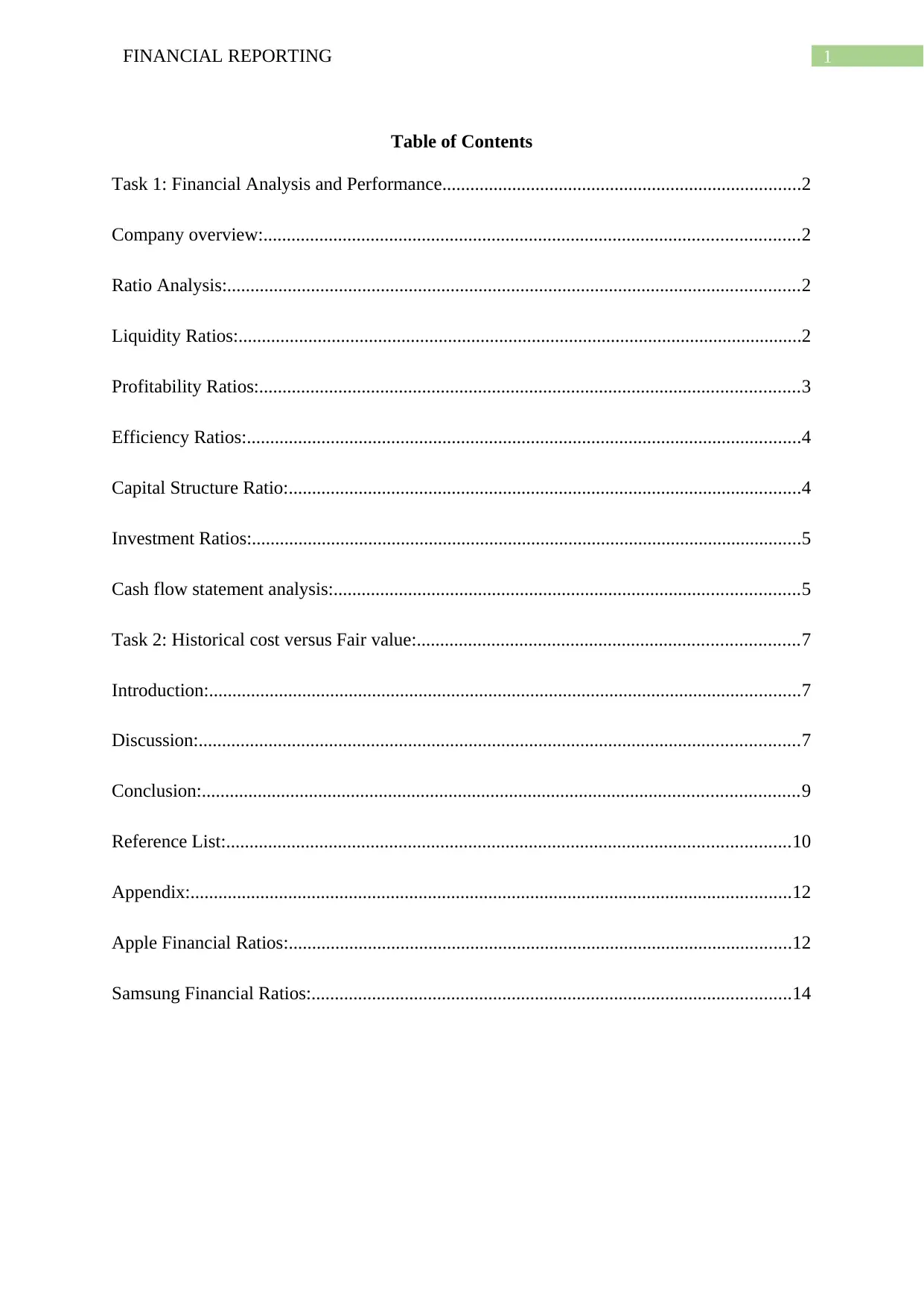
1FINANCIAL REPORTING
Table of Contents
Task 1: Financial Analysis and Performance.............................................................................2
Company overview:...................................................................................................................2
Ratio Analysis:...........................................................................................................................2
Liquidity Ratios:.........................................................................................................................2
Profitability Ratios:....................................................................................................................3
Efficiency Ratios:.......................................................................................................................4
Capital Structure Ratio:..............................................................................................................4
Investment Ratios:......................................................................................................................5
Cash flow statement analysis:....................................................................................................5
Task 2: Historical cost versus Fair value:..................................................................................7
Introduction:...............................................................................................................................7
Discussion:.................................................................................................................................7
Conclusion:................................................................................................................................9
Reference List:.........................................................................................................................10
Appendix:.................................................................................................................................12
Apple Financial Ratios:............................................................................................................12
Samsung Financial Ratios:.......................................................................................................14
Table of Contents
Task 1: Financial Analysis and Performance.............................................................................2
Company overview:...................................................................................................................2
Ratio Analysis:...........................................................................................................................2
Liquidity Ratios:.........................................................................................................................2
Profitability Ratios:....................................................................................................................3
Efficiency Ratios:.......................................................................................................................4
Capital Structure Ratio:..............................................................................................................4
Investment Ratios:......................................................................................................................5
Cash flow statement analysis:....................................................................................................5
Task 2: Historical cost versus Fair value:..................................................................................7
Introduction:...............................................................................................................................7
Discussion:.................................................................................................................................7
Conclusion:................................................................................................................................9
Reference List:.........................................................................................................................10
Appendix:.................................................................................................................................12
Apple Financial Ratios:............................................................................................................12
Samsung Financial Ratios:.......................................................................................................14
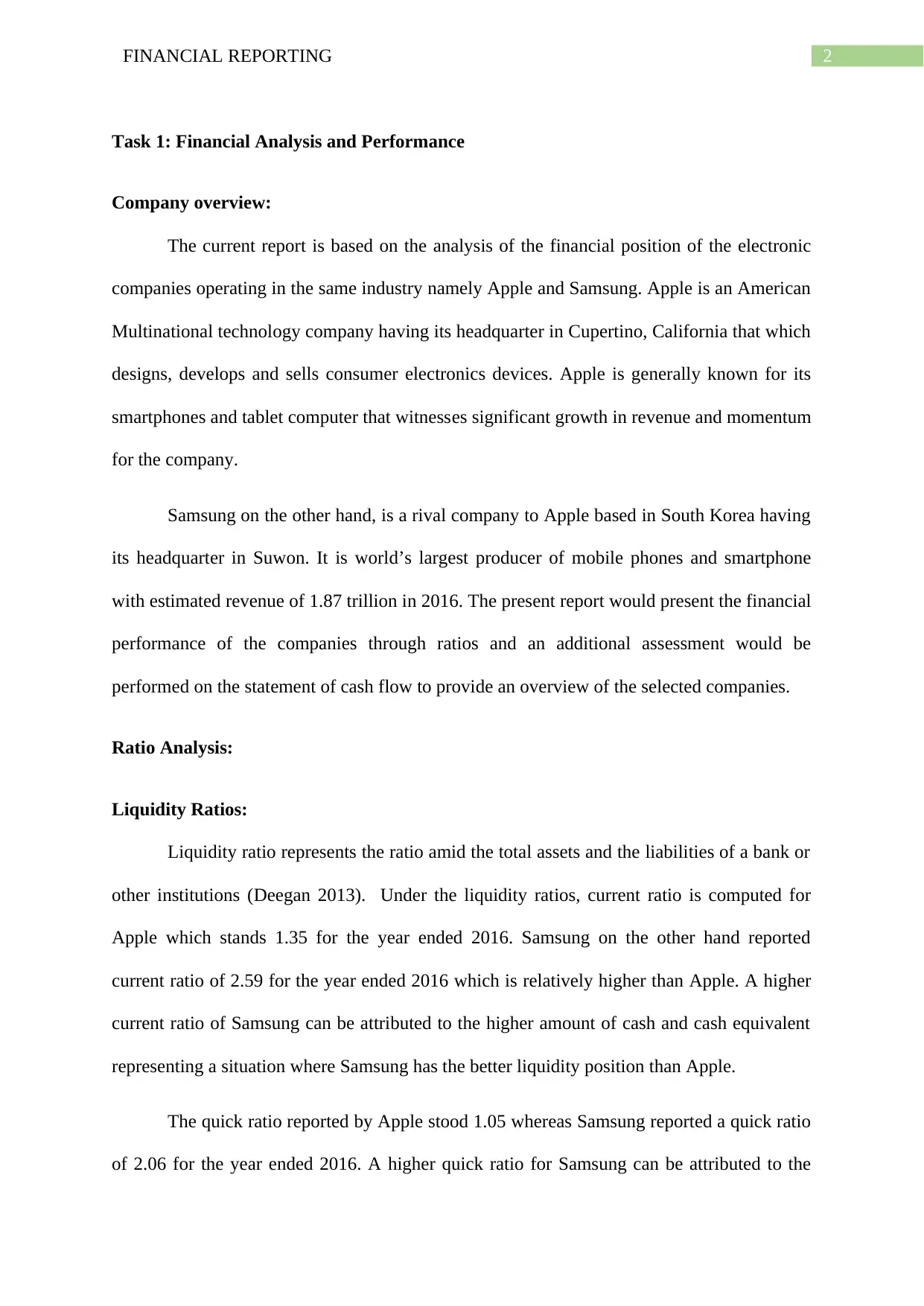
2FINANCIAL REPORTING
Task 1: Financial Analysis and Performance
Company overview:
The current report is based on the analysis of the financial position of the electronic
companies operating in the same industry namely Apple and Samsung. Apple is an American
Multinational technology company having its headquarter in Cupertino, California that which
designs, develops and sells consumer electronics devices. Apple is generally known for its
smartphones and tablet computer that witnesses significant growth in revenue and momentum
for the company.
Samsung on the other hand, is a rival company to Apple based in South Korea having
its headquarter in Suwon. It is world’s largest producer of mobile phones and smartphone
with estimated revenue of 1.87 trillion in 2016. The present report would present the financial
performance of the companies through ratios and an additional assessment would be
performed on the statement of cash flow to provide an overview of the selected companies.
Ratio Analysis:
Liquidity Ratios:
Liquidity ratio represents the ratio amid the total assets and the liabilities of a bank or
other institutions (Deegan 2013). Under the liquidity ratios, current ratio is computed for
Apple which stands 1.35 for the year ended 2016. Samsung on the other hand reported
current ratio of 2.59 for the year ended 2016 which is relatively higher than Apple. A higher
current ratio of Samsung can be attributed to the higher amount of cash and cash equivalent
representing a situation where Samsung has the better liquidity position than Apple.
The quick ratio reported by Apple stood 1.05 whereas Samsung reported a quick ratio
of 2.06 for the year ended 2016. A higher quick ratio for Samsung can be attributed to the
Task 1: Financial Analysis and Performance
Company overview:
The current report is based on the analysis of the financial position of the electronic
companies operating in the same industry namely Apple and Samsung. Apple is an American
Multinational technology company having its headquarter in Cupertino, California that which
designs, develops and sells consumer electronics devices. Apple is generally known for its
smartphones and tablet computer that witnesses significant growth in revenue and momentum
for the company.
Samsung on the other hand, is a rival company to Apple based in South Korea having
its headquarter in Suwon. It is world’s largest producer of mobile phones and smartphone
with estimated revenue of 1.87 trillion in 2016. The present report would present the financial
performance of the companies through ratios and an additional assessment would be
performed on the statement of cash flow to provide an overview of the selected companies.
Ratio Analysis:
Liquidity Ratios:
Liquidity ratio represents the ratio amid the total assets and the liabilities of a bank or
other institutions (Deegan 2013). Under the liquidity ratios, current ratio is computed for
Apple which stands 1.35 for the year ended 2016. Samsung on the other hand reported
current ratio of 2.59 for the year ended 2016 which is relatively higher than Apple. A higher
current ratio of Samsung can be attributed to the higher amount of cash and cash equivalent
representing a situation where Samsung has the better liquidity position than Apple.
The quick ratio reported by Apple stood 1.05 whereas Samsung reported a quick ratio
of 2.06 for the year ended 2016. A higher quick ratio for Samsung can be attributed to the
⊘ This is a preview!⊘
Do you want full access?
Subscribe today to unlock all pages.

Trusted by 1+ million students worldwide
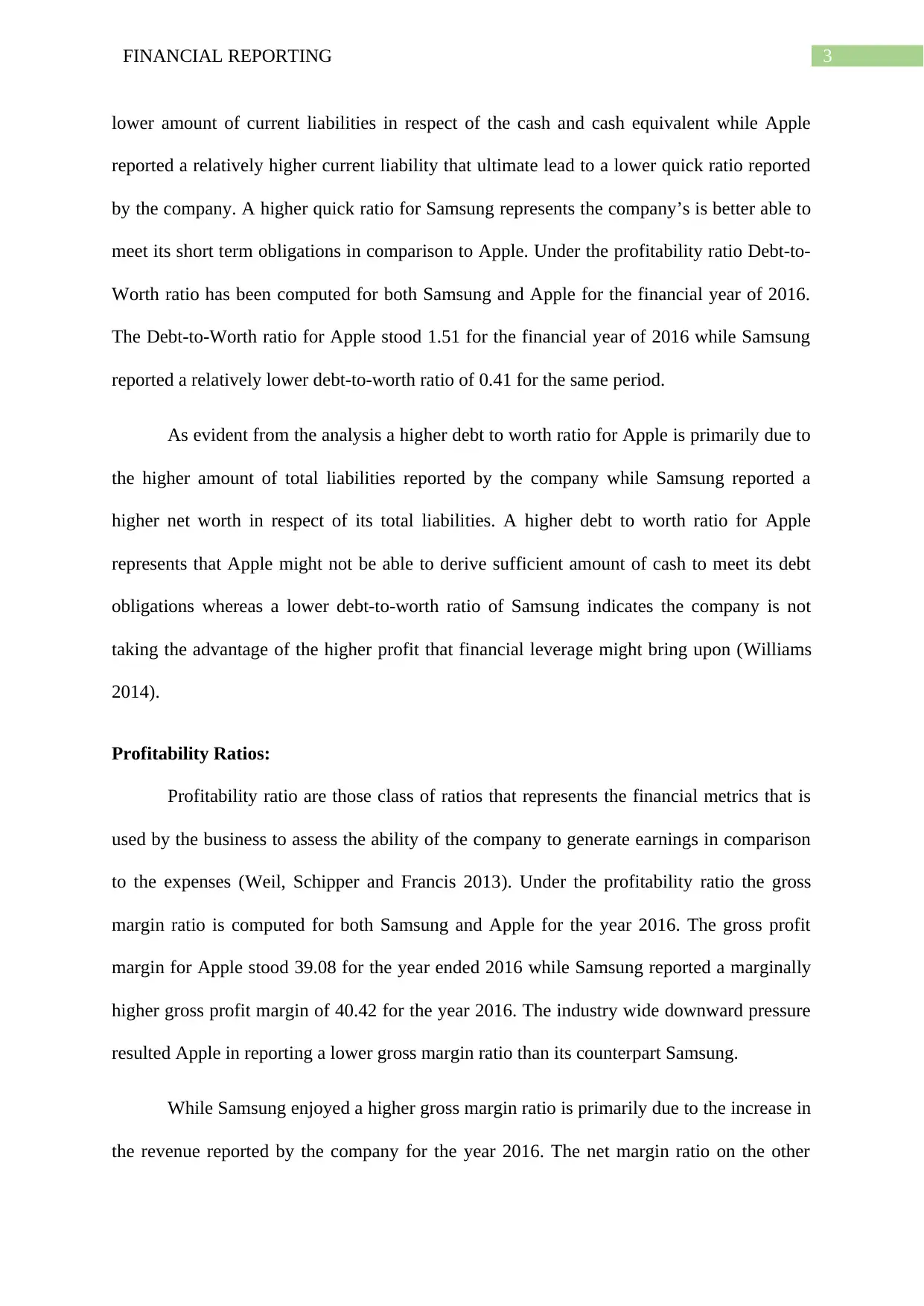
3FINANCIAL REPORTING
lower amount of current liabilities in respect of the cash and cash equivalent while Apple
reported a relatively higher current liability that ultimate lead to a lower quick ratio reported
by the company. A higher quick ratio for Samsung represents the company’s is better able to
meet its short term obligations in comparison to Apple. Under the profitability ratio Debt-to-
Worth ratio has been computed for both Samsung and Apple for the financial year of 2016.
The Debt-to-Worth ratio for Apple stood 1.51 for the financial year of 2016 while Samsung
reported a relatively lower debt-to-worth ratio of 0.41 for the same period.
As evident from the analysis a higher debt to worth ratio for Apple is primarily due to
the higher amount of total liabilities reported by the company while Samsung reported a
higher net worth in respect of its total liabilities. A higher debt to worth ratio for Apple
represents that Apple might not be able to derive sufficient amount of cash to meet its debt
obligations whereas a lower debt-to-worth ratio of Samsung indicates the company is not
taking the advantage of the higher profit that financial leverage might bring upon (Williams
2014).
Profitability Ratios:
Profitability ratio are those class of ratios that represents the financial metrics that is
used by the business to assess the ability of the company to generate earnings in comparison
to the expenses (Weil, Schipper and Francis 2013). Under the profitability ratio the gross
margin ratio is computed for both Samsung and Apple for the year 2016. The gross profit
margin for Apple stood 39.08 for the year ended 2016 while Samsung reported a marginally
higher gross profit margin of 40.42 for the year 2016. The industry wide downward pressure
resulted Apple in reporting a lower gross margin ratio than its counterpart Samsung.
While Samsung enjoyed a higher gross margin ratio is primarily due to the increase in
the revenue reported by the company for the year 2016. The net margin ratio on the other
lower amount of current liabilities in respect of the cash and cash equivalent while Apple
reported a relatively higher current liability that ultimate lead to a lower quick ratio reported
by the company. A higher quick ratio for Samsung represents the company’s is better able to
meet its short term obligations in comparison to Apple. Under the profitability ratio Debt-to-
Worth ratio has been computed for both Samsung and Apple for the financial year of 2016.
The Debt-to-Worth ratio for Apple stood 1.51 for the financial year of 2016 while Samsung
reported a relatively lower debt-to-worth ratio of 0.41 for the same period.
As evident from the analysis a higher debt to worth ratio for Apple is primarily due to
the higher amount of total liabilities reported by the company while Samsung reported a
higher net worth in respect of its total liabilities. A higher debt to worth ratio for Apple
represents that Apple might not be able to derive sufficient amount of cash to meet its debt
obligations whereas a lower debt-to-worth ratio of Samsung indicates the company is not
taking the advantage of the higher profit that financial leverage might bring upon (Williams
2014).
Profitability Ratios:
Profitability ratio are those class of ratios that represents the financial metrics that is
used by the business to assess the ability of the company to generate earnings in comparison
to the expenses (Weil, Schipper and Francis 2013). Under the profitability ratio the gross
margin ratio is computed for both Samsung and Apple for the year 2016. The gross profit
margin for Apple stood 39.08 for the year ended 2016 while Samsung reported a marginally
higher gross profit margin of 40.42 for the year 2016. The industry wide downward pressure
resulted Apple in reporting a lower gross margin ratio than its counterpart Samsung.
While Samsung enjoyed a higher gross margin ratio is primarily due to the increase in
the revenue reported by the company for the year 2016. The net margin ratio on the other
Paraphrase This Document
Need a fresh take? Get an instant paraphrase of this document with our AI Paraphraser
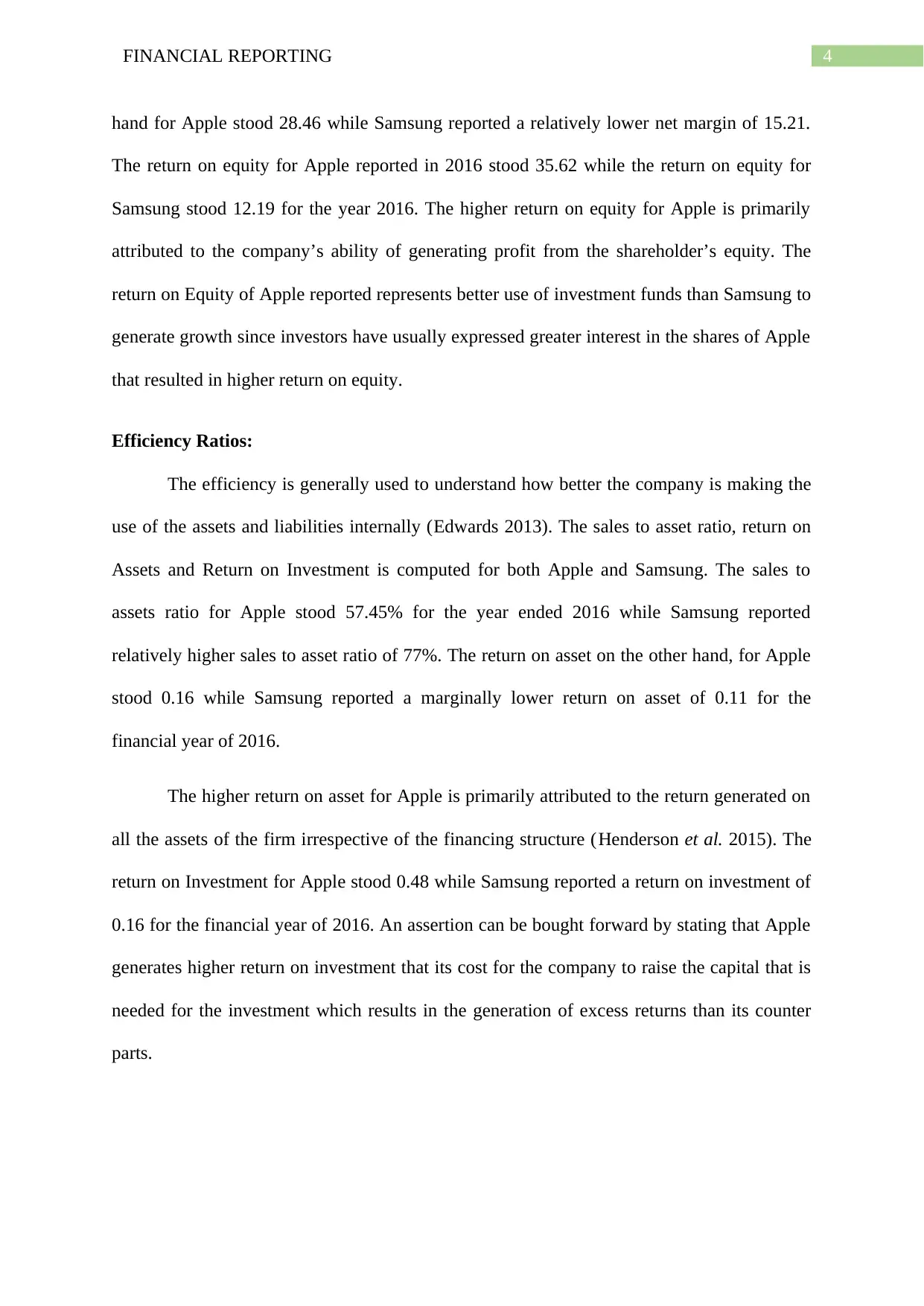
4FINANCIAL REPORTING
hand for Apple stood 28.46 while Samsung reported a relatively lower net margin of 15.21.
The return on equity for Apple reported in 2016 stood 35.62 while the return on equity for
Samsung stood 12.19 for the year 2016. The higher return on equity for Apple is primarily
attributed to the company’s ability of generating profit from the shareholder’s equity. The
return on Equity of Apple reported represents better use of investment funds than Samsung to
generate growth since investors have usually expressed greater interest in the shares of Apple
that resulted in higher return on equity.
Efficiency Ratios:
The efficiency is generally used to understand how better the company is making the
use of the assets and liabilities internally (Edwards 2013). The sales to asset ratio, return on
Assets and Return on Investment is computed for both Apple and Samsung. The sales to
assets ratio for Apple stood 57.45% for the year ended 2016 while Samsung reported
relatively higher sales to asset ratio of 77%. The return on asset on the other hand, for Apple
stood 0.16 while Samsung reported a marginally lower return on asset of 0.11 for the
financial year of 2016.
The higher return on asset for Apple is primarily attributed to the return generated on
all the assets of the firm irrespective of the financing structure (Henderson et al. 2015). The
return on Investment for Apple stood 0.48 while Samsung reported a return on investment of
0.16 for the financial year of 2016. An assertion can be bought forward by stating that Apple
generates higher return on investment that its cost for the company to raise the capital that is
needed for the investment which results in the generation of excess returns than its counter
parts.
hand for Apple stood 28.46 while Samsung reported a relatively lower net margin of 15.21.
The return on equity for Apple reported in 2016 stood 35.62 while the return on equity for
Samsung stood 12.19 for the year 2016. The higher return on equity for Apple is primarily
attributed to the company’s ability of generating profit from the shareholder’s equity. The
return on Equity of Apple reported represents better use of investment funds than Samsung to
generate growth since investors have usually expressed greater interest in the shares of Apple
that resulted in higher return on equity.
Efficiency Ratios:
The efficiency is generally used to understand how better the company is making the
use of the assets and liabilities internally (Edwards 2013). The sales to asset ratio, return on
Assets and Return on Investment is computed for both Apple and Samsung. The sales to
assets ratio for Apple stood 57.45% for the year ended 2016 while Samsung reported
relatively higher sales to asset ratio of 77%. The return on asset on the other hand, for Apple
stood 0.16 while Samsung reported a marginally lower return on asset of 0.11 for the
financial year of 2016.
The higher return on asset for Apple is primarily attributed to the return generated on
all the assets of the firm irrespective of the financing structure (Henderson et al. 2015). The
return on Investment for Apple stood 0.48 while Samsung reported a return on investment of
0.16 for the financial year of 2016. An assertion can be bought forward by stating that Apple
generates higher return on investment that its cost for the company to raise the capital that is
needed for the investment which results in the generation of excess returns than its counter
parts.
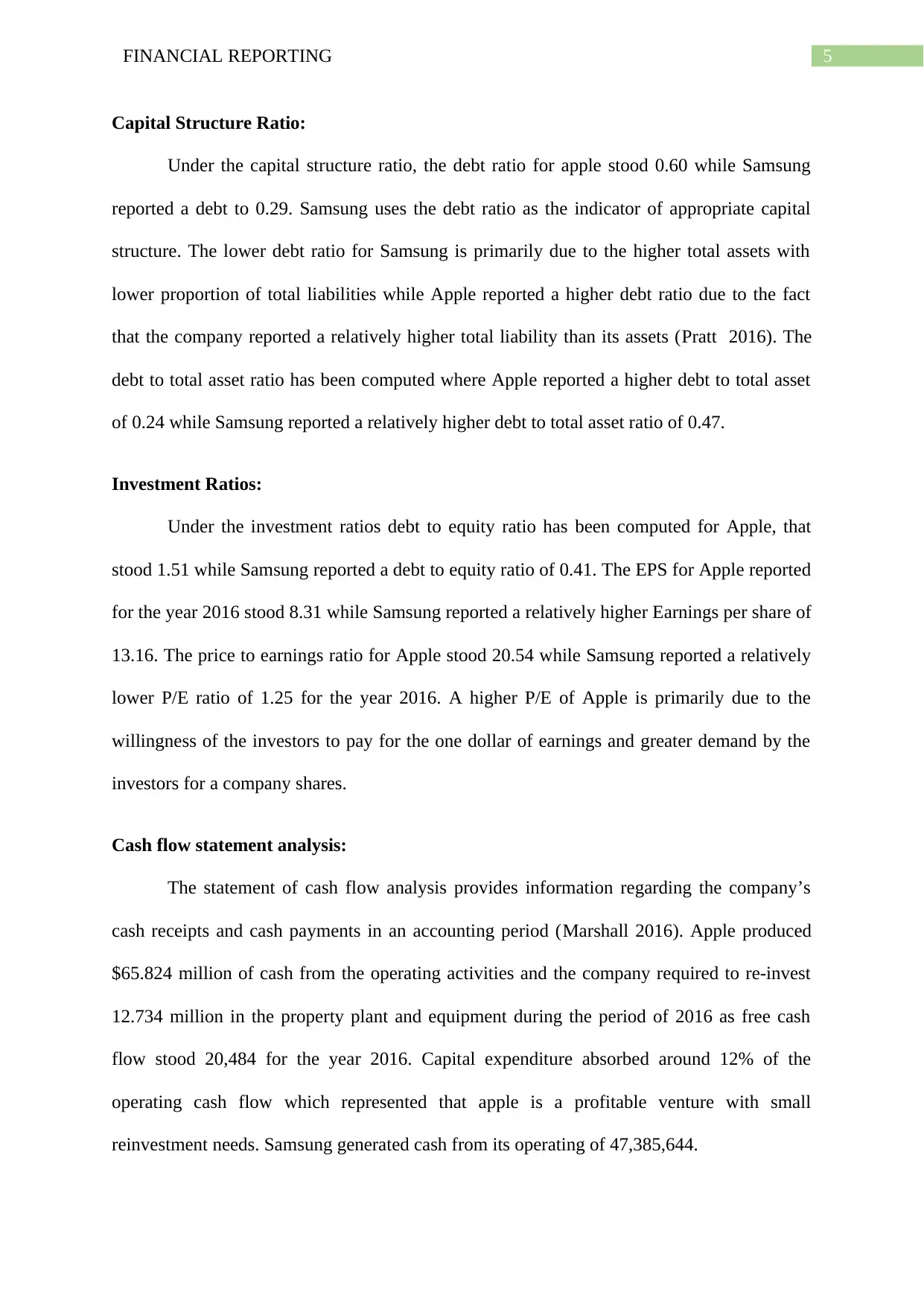
5FINANCIAL REPORTING
Capital Structure Ratio:
Under the capital structure ratio, the debt ratio for apple stood 0.60 while Samsung
reported a debt to 0.29. Samsung uses the debt ratio as the indicator of appropriate capital
structure. The lower debt ratio for Samsung is primarily due to the higher total assets with
lower proportion of total liabilities while Apple reported a higher debt ratio due to the fact
that the company reported a relatively higher total liability than its assets (Pratt 2016). The
debt to total asset ratio has been computed where Apple reported a higher debt to total asset
of 0.24 while Samsung reported a relatively higher debt to total asset ratio of 0.47.
Investment Ratios:
Under the investment ratios debt to equity ratio has been computed for Apple, that
stood 1.51 while Samsung reported a debt to equity ratio of 0.41. The EPS for Apple reported
for the year 2016 stood 8.31 while Samsung reported a relatively higher Earnings per share of
13.16. The price to earnings ratio for Apple stood 20.54 while Samsung reported a relatively
lower P/E ratio of 1.25 for the year 2016. A higher P/E of Apple is primarily due to the
willingness of the investors to pay for the one dollar of earnings and greater demand by the
investors for a company shares.
Cash flow statement analysis:
The statement of cash flow analysis provides information regarding the company’s
cash receipts and cash payments in an accounting period (Marshall 2016). Apple produced
$65.824 million of cash from the operating activities and the company required to re-invest
12.734 million in the property plant and equipment during the period of 2016 as free cash
flow stood 20,484 for the year 2016. Capital expenditure absorbed around 12% of the
operating cash flow which represented that apple is a profitable venture with small
reinvestment needs. Samsung generated cash from its operating of 47,385,644.
Capital Structure Ratio:
Under the capital structure ratio, the debt ratio for apple stood 0.60 while Samsung
reported a debt to 0.29. Samsung uses the debt ratio as the indicator of appropriate capital
structure. The lower debt ratio for Samsung is primarily due to the higher total assets with
lower proportion of total liabilities while Apple reported a higher debt ratio due to the fact
that the company reported a relatively higher total liability than its assets (Pratt 2016). The
debt to total asset ratio has been computed where Apple reported a higher debt to total asset
of 0.24 while Samsung reported a relatively higher debt to total asset ratio of 0.47.
Investment Ratios:
Under the investment ratios debt to equity ratio has been computed for Apple, that
stood 1.51 while Samsung reported a debt to equity ratio of 0.41. The EPS for Apple reported
for the year 2016 stood 8.31 while Samsung reported a relatively higher Earnings per share of
13.16. The price to earnings ratio for Apple stood 20.54 while Samsung reported a relatively
lower P/E ratio of 1.25 for the year 2016. A higher P/E of Apple is primarily due to the
willingness of the investors to pay for the one dollar of earnings and greater demand by the
investors for a company shares.
Cash flow statement analysis:
The statement of cash flow analysis provides information regarding the company’s
cash receipts and cash payments in an accounting period (Marshall 2016). Apple produced
$65.824 million of cash from the operating activities and the company required to re-invest
12.734 million in the property plant and equipment during the period of 2016 as free cash
flow stood 20,484 for the year 2016. Capital expenditure absorbed around 12% of the
operating cash flow which represented that apple is a profitable venture with small
reinvestment needs. Samsung generated cash from its operating of 47,385,644.
⊘ This is a preview!⊘
Do you want full access?
Subscribe today to unlock all pages.

Trusted by 1+ million students worldwide
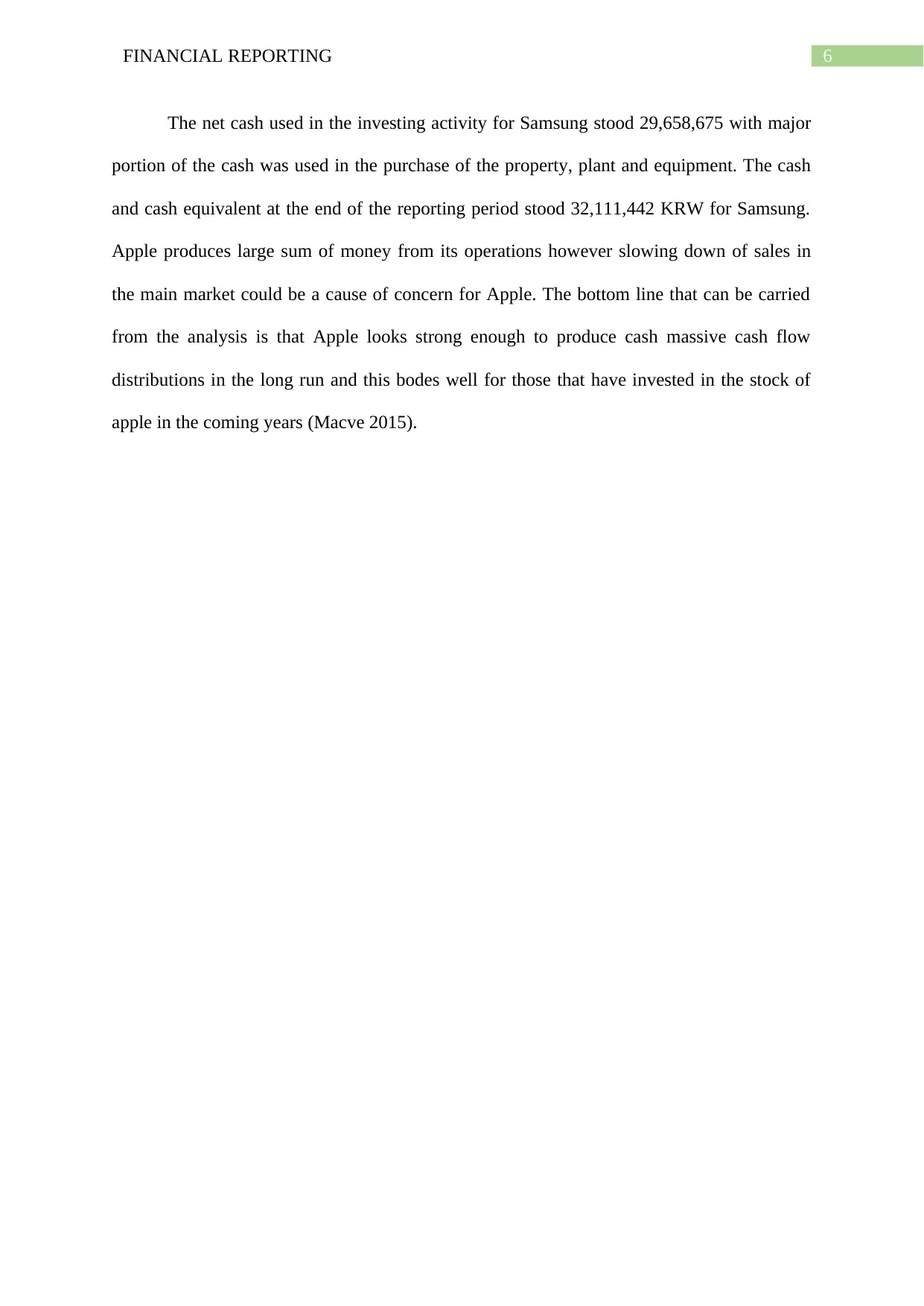
6FINANCIAL REPORTING
The net cash used in the investing activity for Samsung stood 29,658,675 with major
portion of the cash was used in the purchase of the property, plant and equipment. The cash
and cash equivalent at the end of the reporting period stood 32,111,442 KRW for Samsung.
Apple produces large sum of money from its operations however slowing down of sales in
the main market could be a cause of concern for Apple. The bottom line that can be carried
from the analysis is that Apple looks strong enough to produce cash massive cash flow
distributions in the long run and this bodes well for those that have invested in the stock of
apple in the coming years (Macve 2015).
The net cash used in the investing activity for Samsung stood 29,658,675 with major
portion of the cash was used in the purchase of the property, plant and equipment. The cash
and cash equivalent at the end of the reporting period stood 32,111,442 KRW for Samsung.
Apple produces large sum of money from its operations however slowing down of sales in
the main market could be a cause of concern for Apple. The bottom line that can be carried
from the analysis is that Apple looks strong enough to produce cash massive cash flow
distributions in the long run and this bodes well for those that have invested in the stock of
apple in the coming years (Macve 2015).
Paraphrase This Document
Need a fresh take? Get an instant paraphrase of this document with our AI Paraphraser
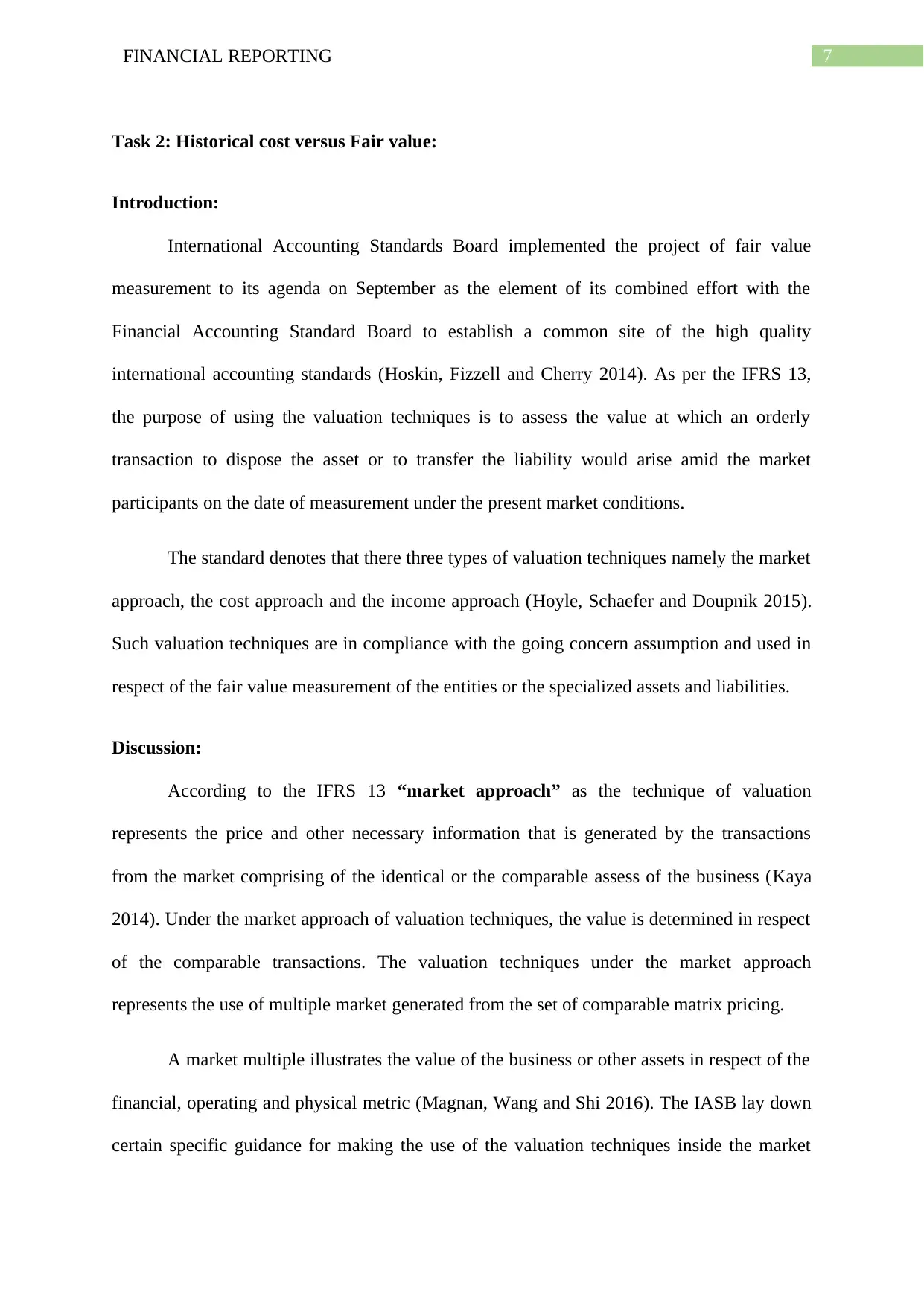
7FINANCIAL REPORTING
Task 2: Historical cost versus Fair value:
Introduction:
International Accounting Standards Board implemented the project of fair value
measurement to its agenda on September as the element of its combined effort with the
Financial Accounting Standard Board to establish a common site of the high quality
international accounting standards (Hoskin, Fizzell and Cherry 2014). As per the IFRS 13,
the purpose of using the valuation techniques is to assess the value at which an orderly
transaction to dispose the asset or to transfer the liability would arise amid the market
participants on the date of measurement under the present market conditions.
The standard denotes that there three types of valuation techniques namely the market
approach, the cost approach and the income approach (Hoyle, Schaefer and Doupnik 2015).
Such valuation techniques are in compliance with the going concern assumption and used in
respect of the fair value measurement of the entities or the specialized assets and liabilities.
Discussion:
According to the IFRS 13 “market approach” as the technique of valuation
represents the price and other necessary information that is generated by the transactions
from the market comprising of the identical or the comparable assess of the business (Kaya
2014). Under the market approach of valuation techniques, the value is determined in respect
of the comparable transactions. The valuation techniques under the market approach
represents the use of multiple market generated from the set of comparable matrix pricing.
A market multiple illustrates the value of the business or other assets in respect of the
financial, operating and physical metric (Magnan, Wang and Shi 2016). The IASB lay down
certain specific guidance for making the use of the valuation techniques inside the market
Task 2: Historical cost versus Fair value:
Introduction:
International Accounting Standards Board implemented the project of fair value
measurement to its agenda on September as the element of its combined effort with the
Financial Accounting Standard Board to establish a common site of the high quality
international accounting standards (Hoskin, Fizzell and Cherry 2014). As per the IFRS 13,
the purpose of using the valuation techniques is to assess the value at which an orderly
transaction to dispose the asset or to transfer the liability would arise amid the market
participants on the date of measurement under the present market conditions.
The standard denotes that there three types of valuation techniques namely the market
approach, the cost approach and the income approach (Hoyle, Schaefer and Doupnik 2015).
Such valuation techniques are in compliance with the going concern assumption and used in
respect of the fair value measurement of the entities or the specialized assets and liabilities.
Discussion:
According to the IFRS 13 “market approach” as the technique of valuation
represents the price and other necessary information that is generated by the transactions
from the market comprising of the identical or the comparable assess of the business (Kaya
2014). Under the market approach of valuation techniques, the value is determined in respect
of the comparable transactions. The valuation techniques under the market approach
represents the use of multiple market generated from the set of comparable matrix pricing.
A market multiple illustrates the value of the business or other assets in respect of the
financial, operating and physical metric (Magnan, Wang and Shi 2016). The IASB lay down
certain specific guidance for making the use of the valuation techniques inside the market

8FINANCIAL REPORTING
approach. Valuation multiple can be computed either for the holders of equity or for the debt
holders.
IFRS 13 on other hand defines “cost approach” as another valuation technique which
assist in reflecting the amount that would be needed presently to replace the service capacity
of the asset (Zack 2013). In respect of the Cost Approach, the fair value represents the cost to
acquire or construct a substitute asset of the comparability utility which is adjusted for
obsolesce including the physical wear and economic obsolescence. The cost approach of
valuation helps in estimating the fair value by making use of the fair value in terms of the
economic principle which the purchaser would pay for an asset not greater than the cost to get
the asset of equal utility.
On implementing the cost approach an important considerations need to be
undertaken such as availability of comprehensive cost data, functional and economic
obsolescence from inflation and loss of profit during reproduction (Christensen and Nikolaev
2013). One of the example of valuation technique that is based on the cost approach is
Depreciated Replacement Cost method. Under this method it represents that a potential
purchaser would be prepared to pay for the subject asset if it were new on the date of
valuation. In such a situation adjustment for depreciation should be made in respect of cost of
alternative asset.
IFRS 13 states the income approach in the form of valuation techniques which can
convert the future amounts to the single amount. The fair value measurement is determined
based on the value demonstrated by the present market expectations regarding those future
amounts (Jack 2015). The valuation technique that is associated with the income approach is
reliant on the projected future income and profit or cash flows. Under the income approach an
income stream which is probably to remain constant is capitalized under the single multiplier.
approach. Valuation multiple can be computed either for the holders of equity or for the debt
holders.
IFRS 13 on other hand defines “cost approach” as another valuation technique which
assist in reflecting the amount that would be needed presently to replace the service capacity
of the asset (Zack 2013). In respect of the Cost Approach, the fair value represents the cost to
acquire or construct a substitute asset of the comparability utility which is adjusted for
obsolesce including the physical wear and economic obsolescence. The cost approach of
valuation helps in estimating the fair value by making use of the fair value in terms of the
economic principle which the purchaser would pay for an asset not greater than the cost to get
the asset of equal utility.
On implementing the cost approach an important considerations need to be
undertaken such as availability of comprehensive cost data, functional and economic
obsolescence from inflation and loss of profit during reproduction (Christensen and Nikolaev
2013). One of the example of valuation technique that is based on the cost approach is
Depreciated Replacement Cost method. Under this method it represents that a potential
purchaser would be prepared to pay for the subject asset if it were new on the date of
valuation. In such a situation adjustment for depreciation should be made in respect of cost of
alternative asset.
IFRS 13 states the income approach in the form of valuation techniques which can
convert the future amounts to the single amount. The fair value measurement is determined
based on the value demonstrated by the present market expectations regarding those future
amounts (Jack 2015). The valuation technique that is associated with the income approach is
reliant on the projected future income and profit or cash flows. Under the income approach an
income stream which is probably to remain constant is capitalized under the single multiplier.
⊘ This is a preview!⊘
Do you want full access?
Subscribe today to unlock all pages.

Trusted by 1+ million students worldwide
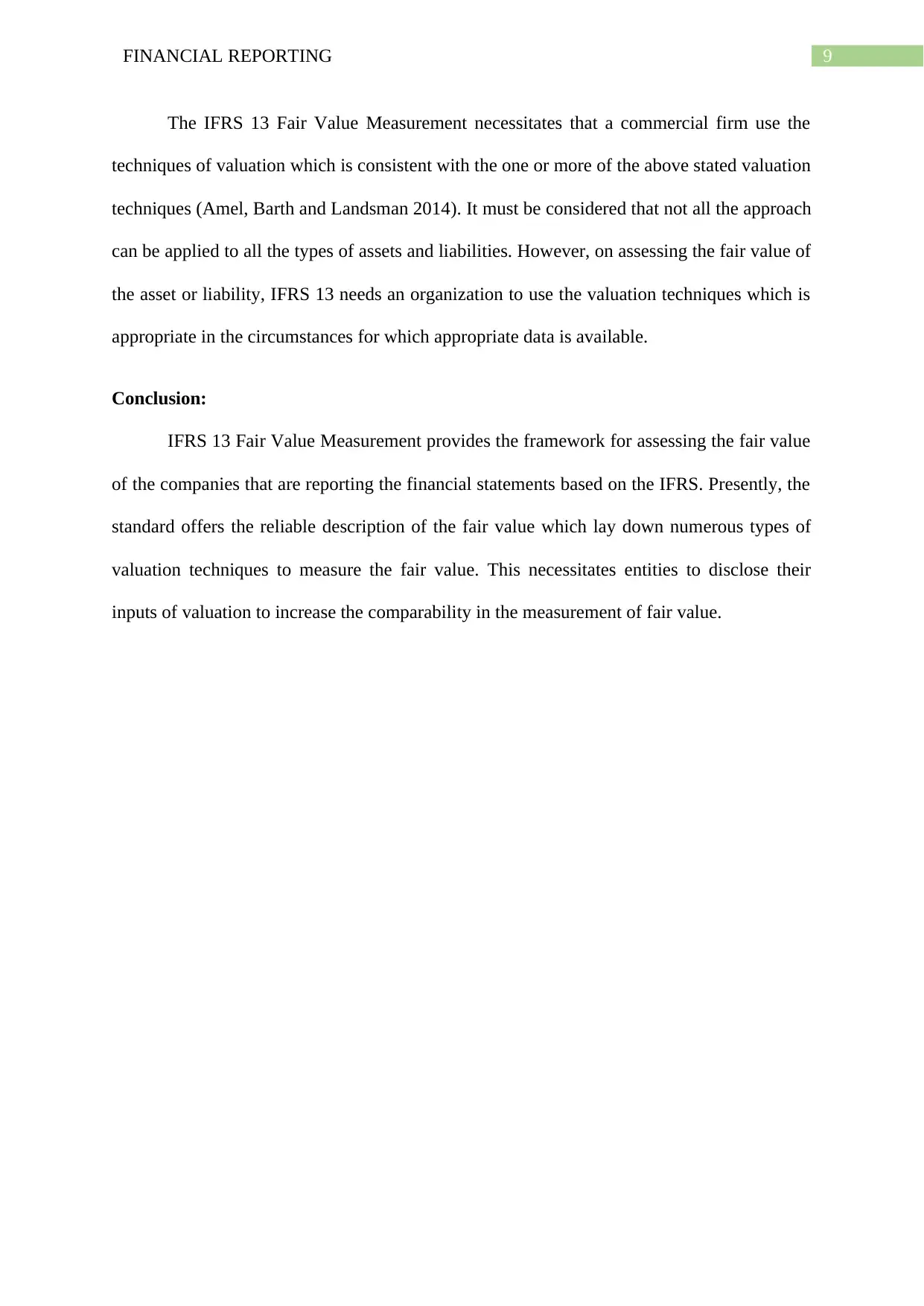
9FINANCIAL REPORTING
The IFRS 13 Fair Value Measurement necessitates that a commercial firm use the
techniques of valuation which is consistent with the one or more of the above stated valuation
techniques (Amel, Barth and Landsman 2014). It must be considered that not all the approach
can be applied to all the types of assets and liabilities. However, on assessing the fair value of
the asset or liability, IFRS 13 needs an organization to use the valuation techniques which is
appropriate in the circumstances for which appropriate data is available.
Conclusion:
IFRS 13 Fair Value Measurement provides the framework for assessing the fair value
of the companies that are reporting the financial statements based on the IFRS. Presently, the
standard offers the reliable description of the fair value which lay down numerous types of
valuation techniques to measure the fair value. This necessitates entities to disclose their
inputs of valuation to increase the comparability in the measurement of fair value.
The IFRS 13 Fair Value Measurement necessitates that a commercial firm use the
techniques of valuation which is consistent with the one or more of the above stated valuation
techniques (Amel, Barth and Landsman 2014). It must be considered that not all the approach
can be applied to all the types of assets and liabilities. However, on assessing the fair value of
the asset or liability, IFRS 13 needs an organization to use the valuation techniques which is
appropriate in the circumstances for which appropriate data is available.
Conclusion:
IFRS 13 Fair Value Measurement provides the framework for assessing the fair value
of the companies that are reporting the financial statements based on the IFRS. Presently, the
standard offers the reliable description of the fair value which lay down numerous types of
valuation techniques to measure the fair value. This necessitates entities to disclose their
inputs of valuation to increase the comparability in the measurement of fair value.
Paraphrase This Document
Need a fresh take? Get an instant paraphrase of this document with our AI Paraphraser
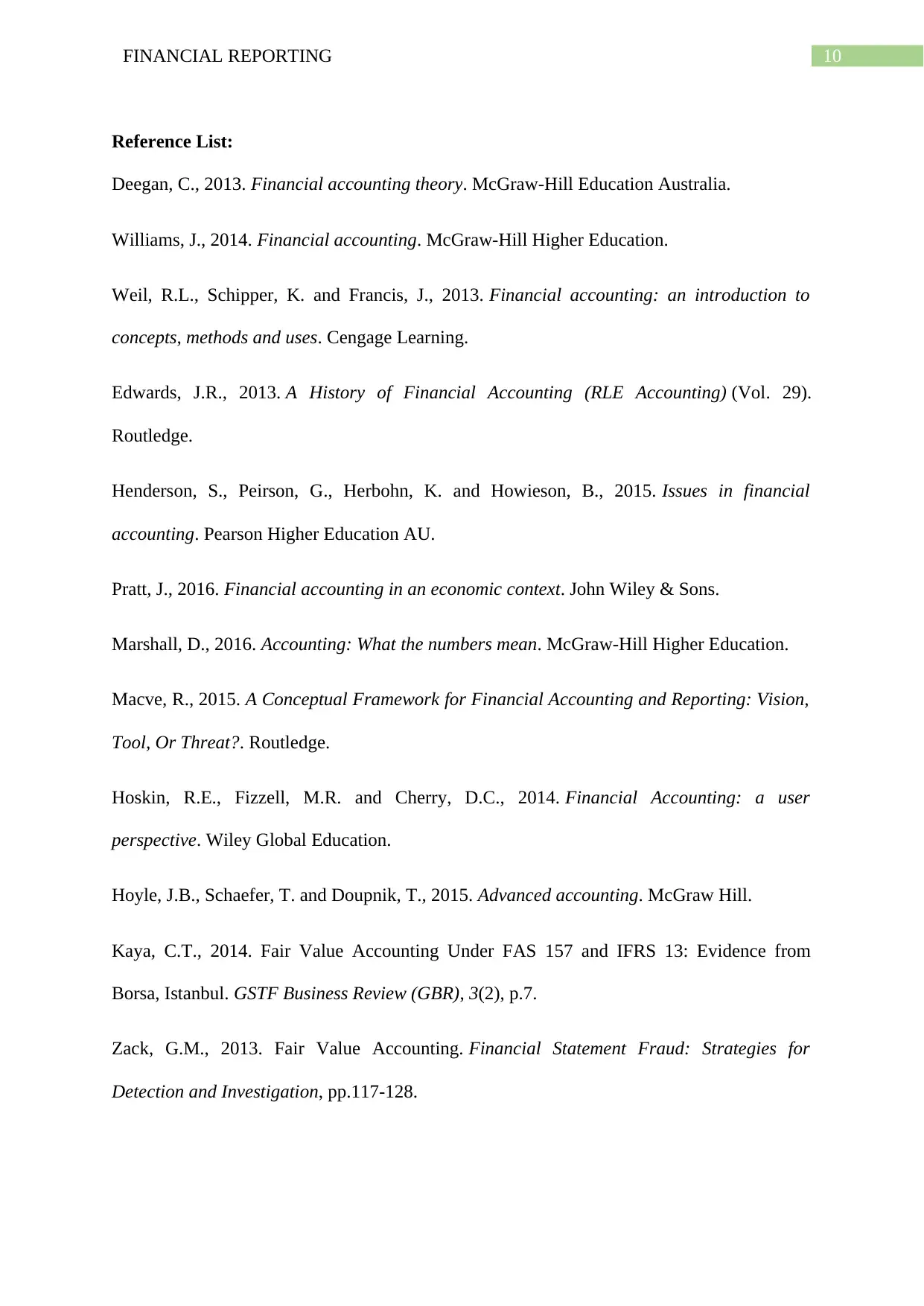
10FINANCIAL REPORTING
Reference List:
Deegan, C., 2013. Financial accounting theory. McGraw-Hill Education Australia.
Williams, J., 2014. Financial accounting. McGraw-Hill Higher Education.
Weil, R.L., Schipper, K. and Francis, J., 2013. Financial accounting: an introduction to
concepts, methods and uses. Cengage Learning.
Edwards, J.R., 2013. A History of Financial Accounting (RLE Accounting) (Vol. 29).
Routledge.
Henderson, S., Peirson, G., Herbohn, K. and Howieson, B., 2015. Issues in financial
accounting. Pearson Higher Education AU.
Pratt, J., 2016. Financial accounting in an economic context. John Wiley & Sons.
Marshall, D., 2016. Accounting: What the numbers mean. McGraw-Hill Higher Education.
Macve, R., 2015. A Conceptual Framework for Financial Accounting and Reporting: Vision,
Tool, Or Threat?. Routledge.
Hoskin, R.E., Fizzell, M.R. and Cherry, D.C., 2014. Financial Accounting: a user
perspective. Wiley Global Education.
Hoyle, J.B., Schaefer, T. and Doupnik, T., 2015. Advanced accounting. McGraw Hill.
Kaya, C.T., 2014. Fair Value Accounting Under FAS 157 and IFRS 13: Evidence from
Borsa, Istanbul. GSTF Business Review (GBR), 3(2), p.7.
Zack, G.M., 2013. Fair Value Accounting. Financial Statement Fraud: Strategies for
Detection and Investigation, pp.117-128.
Reference List:
Deegan, C., 2013. Financial accounting theory. McGraw-Hill Education Australia.
Williams, J., 2014. Financial accounting. McGraw-Hill Higher Education.
Weil, R.L., Schipper, K. and Francis, J., 2013. Financial accounting: an introduction to
concepts, methods and uses. Cengage Learning.
Edwards, J.R., 2013. A History of Financial Accounting (RLE Accounting) (Vol. 29).
Routledge.
Henderson, S., Peirson, G., Herbohn, K. and Howieson, B., 2015. Issues in financial
accounting. Pearson Higher Education AU.
Pratt, J., 2016. Financial accounting in an economic context. John Wiley & Sons.
Marshall, D., 2016. Accounting: What the numbers mean. McGraw-Hill Higher Education.
Macve, R., 2015. A Conceptual Framework for Financial Accounting and Reporting: Vision,
Tool, Or Threat?. Routledge.
Hoskin, R.E., Fizzell, M.R. and Cherry, D.C., 2014. Financial Accounting: a user
perspective. Wiley Global Education.
Hoyle, J.B., Schaefer, T. and Doupnik, T., 2015. Advanced accounting. McGraw Hill.
Kaya, C.T., 2014. Fair Value Accounting Under FAS 157 and IFRS 13: Evidence from
Borsa, Istanbul. GSTF Business Review (GBR), 3(2), p.7.
Zack, G.M., 2013. Fair Value Accounting. Financial Statement Fraud: Strategies for
Detection and Investigation, pp.117-128.
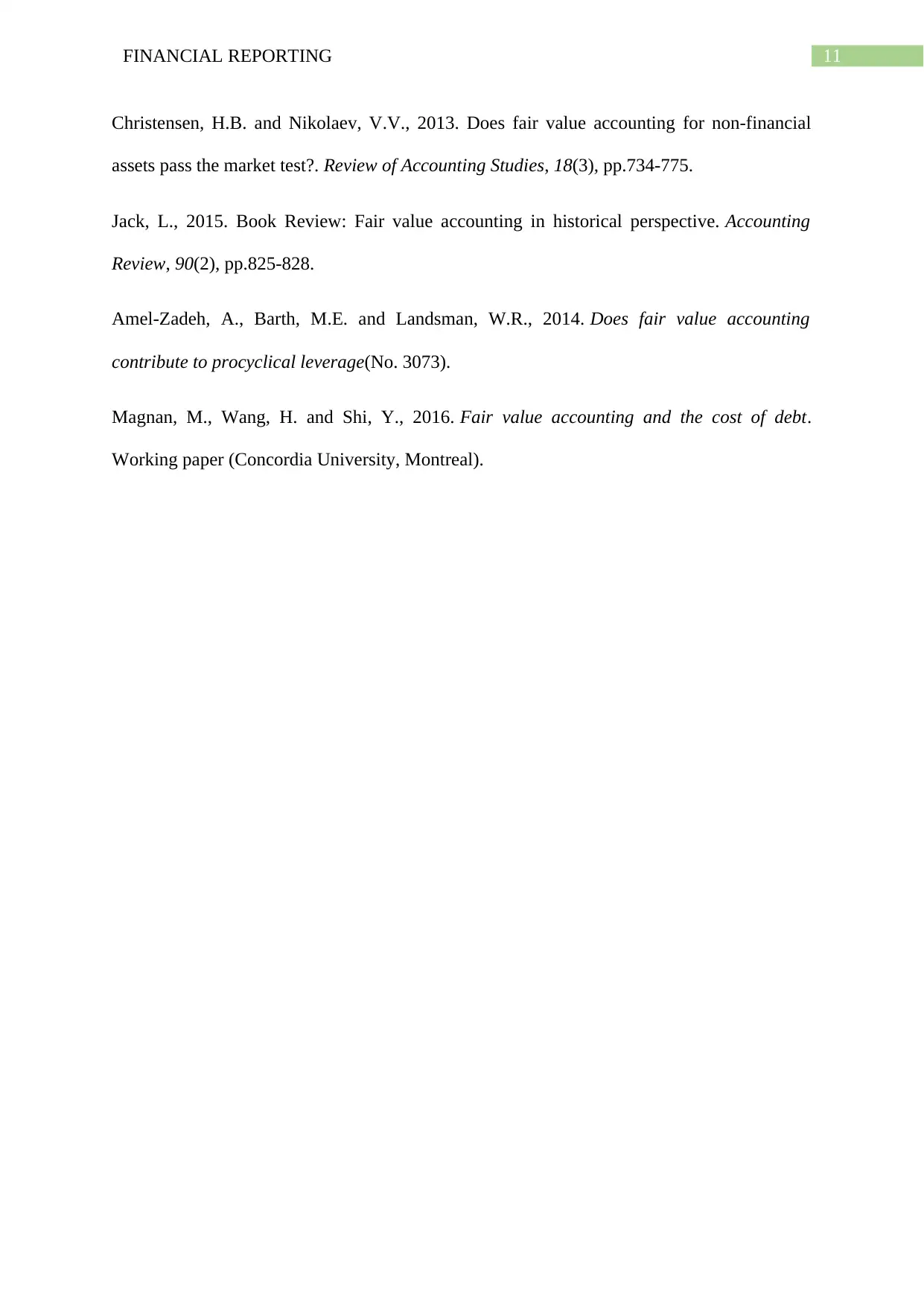
11FINANCIAL REPORTING
Christensen, H.B. and Nikolaev, V.V., 2013. Does fair value accounting for non-financial
assets pass the market test?. Review of Accounting Studies, 18(3), pp.734-775.
Jack, L., 2015. Book Review: Fair value accounting in historical perspective. Accounting
Review, 90(2), pp.825-828.
Amel-Zadeh, A., Barth, M.E. and Landsman, W.R., 2014. Does fair value accounting
contribute to procyclical leverage(No. 3073).
Magnan, M., Wang, H. and Shi, Y., 2016. Fair value accounting and the cost of debt.
Working paper (Concordia University, Montreal).
Christensen, H.B. and Nikolaev, V.V., 2013. Does fair value accounting for non-financial
assets pass the market test?. Review of Accounting Studies, 18(3), pp.734-775.
Jack, L., 2015. Book Review: Fair value accounting in historical perspective. Accounting
Review, 90(2), pp.825-828.
Amel-Zadeh, A., Barth, M.E. and Landsman, W.R., 2014. Does fair value accounting
contribute to procyclical leverage(No. 3073).
Magnan, M., Wang, H. and Shi, Y., 2016. Fair value accounting and the cost of debt.
Working paper (Concordia University, Montreal).
⊘ This is a preview!⊘
Do you want full access?
Subscribe today to unlock all pages.

Trusted by 1+ million students worldwide
1 out of 16
Related Documents
Your All-in-One AI-Powered Toolkit for Academic Success.
+13062052269
info@desklib.com
Available 24*7 on WhatsApp / Email
![[object Object]](/_next/static/media/star-bottom.7253800d.svg)
Unlock your academic potential
Copyright © 2020–2025 A2Z Services. All Rights Reserved. Developed and managed by ZUCOL.





